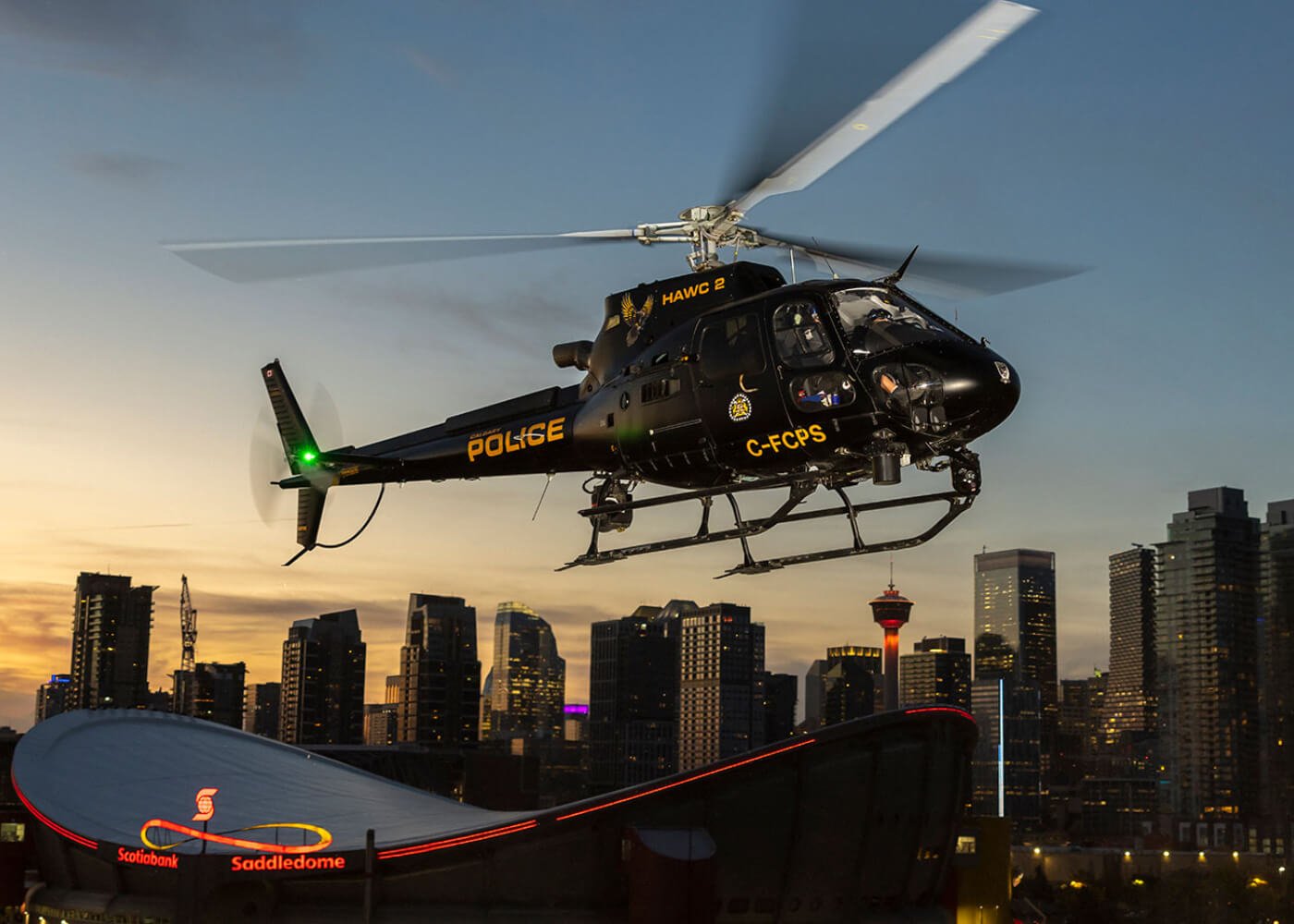There’s no such thing as a typical day for the officers at the Calgary Police Services Air Support Unit, commonly known as the Helicopter Air Watch for Community Safety (HAWCS). Crews often come face-to-face with a range of calls that can take them anywhere across Alberta’s largest city.
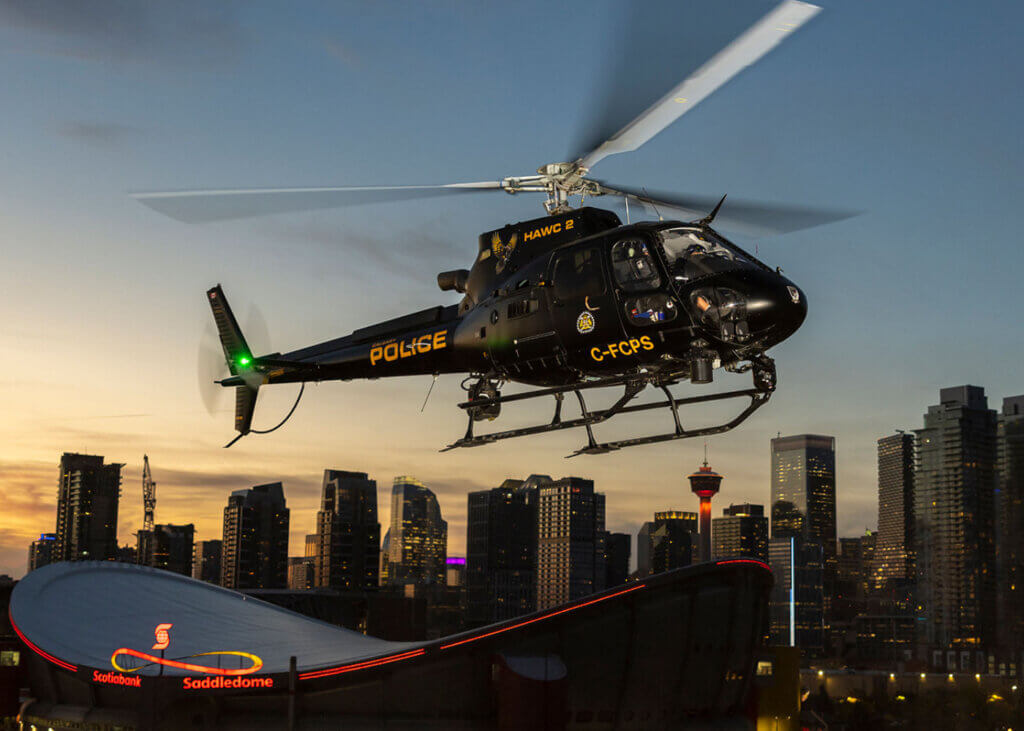
“We could start off with a stolen vehicle, [and go] to a missing person, to a suicidal person,” said Brian Vale, a civilian helicopter pilot who has been with the Calgary Police since October 2015. “It just depends on the day. We’re used for everything.”
As the first and oldest municipal airborne law enforcement unit in Canada, HAWCS has tallied up an endless number of success stories over its 28-year history, and now with a new fleet of two Airbus H125s, it offers an upgraded capability as it patrols the skies of Calgary.
“In 2020, we had a call of a broad daylight homicide,” said Sgt. Tanya Paziuk, unit manager of HAWCS. “There was a group of three people involved in organized crime that shot and killed someone in a park where kids were playing. Because we were already airborne, we were first on scene, and we were able to offer a much safer platform for officers to enter the area where the shooting occurred.”
Constable Kyle Palyga was the tactical flight officer (TFO) on duty that day. As a member of HAWCS since 2017, Palyga was tasked with locating the suspects using what little description he got of the fleeing silver Mercedes SUV.
Despite the brief description, Palyga’s vantage point from the sky allowed him to pick out the vehicle within 10 minutes. The tactical unit fell back to let Palyga track the SUV to a neighborhood near the Calgary International Airport. They also located and later retrieved the gun that was used in the homicide.
“We had three offenders bail out of the vehicle — they got out thinking they were safe and ran in three different directions,” he said. “We were able to track all three, get them into custody with our tactical team, and pretty much solve a homicide. By us being there, we prevented a [ground] pursuit where we didn’t have to chase someone.”
Palyga said he later found out from the homicide officer on scene that the shooter was brought in from out of town to carry out the hit.
“We potentially saved a million-dollar investigation with the helicopter,” Palyga said. “That’s just one example. Our crews go out and make good catches every day and night. We are catching hundreds of offenders every year with this helicopter.”

Paziuk echoed that sentiment, asserting that the HAWCS program “has been one of the most important assets that the City of Calgary Police Service has. There’s no question — it has continued to prove itself every year.”
Paziuk, Palyga and Vale are just three of the members that make up the Calgary airborne unit. HAWCS is staffed by five full-time civilian pilots, two full-time aircraft maintenance engineers (AMEs), one sergeant and four TFOs. The team works two shifts around the clock to serve 1.3 million people in Calgary and the surrounding area.
“I think there’s a benefit [to using civilian pilots], especially to us here in Calgary where a lot of our airspace can be very complicated,” Palyga said. “It takes skill and experience. We want people who have a few thousand hours as pilots.”
To become a pilot at Calgary Police, one needs 3,000 hours of pilot in command (PIC) time, night rating, night vision goggle (NVG) time, Group 4 instrument flight rules (IFR) rating, and basic knowledge of the Calgary area.
“To try and find a trained police officer with [that] experience … is hard to do. I think having civilians learn the police side of things is a little bit easier to train,” said Cam Buschert, chief pilot with HAWCS for nine years. “We also want our pilots to focus on aviation safety over anything else.”

The unit is on pace to fly around 2,800 hours this year with its two H125s. HAWCS averages more than 4,000 calls for service annually, and has been involved in laying over 2,000 Criminal Code charges and apprehending offenders with over 1,000 warrants collectively.
“These helicopters have been a game-changer for us in our missions,” Paziuk said. “I can’t imagine policing without a helicopter. It’s the most effective tool that we have in our entire service. There’s so much more safety built into us by having that aerial platform and that ability to see what others can’t see.”
Ask anyone at the air support unit and they’ll say that these aircraft have proven their worth over the years, becoming key assets for HAWCS to provide aerial safety to the city and its surrounding communities. They’re often used for tracking offenders, responding to public safety events like robberies, shootings or assaults, or locating vulnerable, missing or suicidal people.
As the reliable eyes in the sky, HAWCS is often the first on scene, providing an aerial overview to the officers on the ground and improving the situational awareness for the entire unit.
“Everything’s recorded,” Paziuk said. “We have a downlink capability where we’re streaming it live to incident commanders. Incident commanders then have the capability to make better decisions, deploy the right resources, and get things in place when there is a suitable time to either apprehend the offender or locate the victim.”
With a comprehensive collection of stats and data, the air support unit tracks what it calls a HAWCS Catch, “which is an incident or a call where we likely wouldn’t have had any success without the helicopter,” Paziuk said. “We average over 750 HAWCS Catches every year.”

A new capable fleet
During Scott Conlin’s 24-year tenure at HAWCS, the director of maintenance and chief engineer has seen the unit go through three different helicopter models, evolving from the MD 520N when HAWCS first started in 1995, to the Airbus EC120, and now to the H125. The second H125 aircraft was delivered in 2021.
He said the unit’s two EC120s served HAWCS well throughout the years — both putting around 18,000 flight hours on each of their airframes. But after 15 years of flying in HAWCS, it had been time for an upgrade.
The unit turned to the H125s believing the aircraft’s improved fuel capacity and payload capabilities would give the helicopter enough endurance to respond to more calls for service with more crews onboard — a task that officers struggled with in their former EC120.
“With the 120s, none of the crews could take a full tank of gas,” said Susan Colbert, who has been a civilian pilot with HAWCS for nine years. “Now, we can even take at least one ride-along with a full tank, and sometimes two depending on the total weight.”
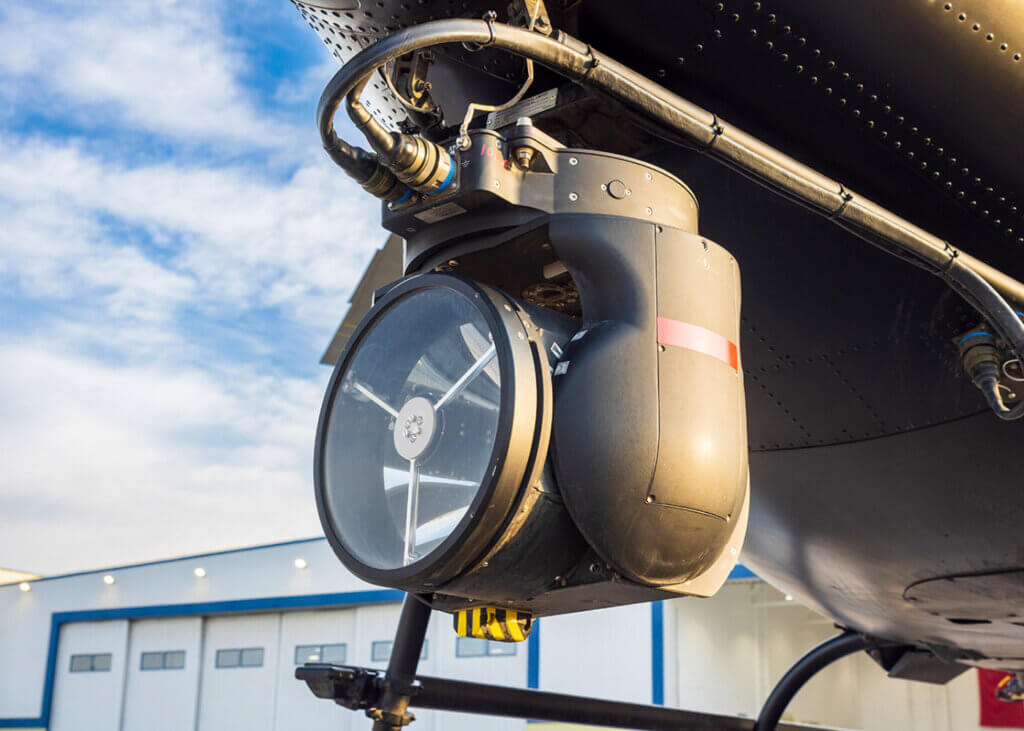
As a TFO, Constable Derek Field agrees that one of the biggest improvements gained from upgrading to the H125 is the greater fuel capacity. Field has been with HAWCS since 2014.
“With the 120, we could go for approximately two hours, and if we had somebody with us, we were down to about an hour worth of fuel,” Field said. “A lot of times, we’d be halfway through our flight, get a call of a stolen vehicle, and then we’d run out of fuel.”
Powered by Safran’s Arriel 2D turboshaft engine with a dual-channel full authority digital engine control (FADEC) unit, the H125 has an endurance of more than 4.5 hours and range of 340 nautical miles (630 kilometers) at a cruise speed of 140 knots (260 kilometers per hour).
The aircraft’s modern Garmin G500H TXi avionics were developed for enhanced pilot safety and reduced workload. The H125 is also equipped with a vehicle and engine multifunction display (VEMD), as well as a crash-resistant fuel system.
The completion was managed by Airbus Helicopters and carried out by Eagle Copters in Calgary — just blocks away from Calgary Police. Having been a part of the EC120 completion and several generations of mission suites, Conlin “took a lot of lessons from those older aircraft — what we changed, what we liked, what we didn’t like — and applied them to this aircraft.”
Satisfied with how the completion went, Conlin said Eagle “brought some innovative ideas to the table, and Airbus was excellent about allowing us to make changes on the fly as we saw things being put together.”

Paziuk added that working with Eagle and Airbus was “a great team experience. There was always the desire to make an exceptional product and make it very custom to our needs. I joked that often their response time was about 30 seconds when you sent an email, so it was exceptional customer service.”
Innovative law enforcement equipment
Along with upgrading the aircraft, the unit also upgraded some of its law enforcement technology, including its camera system. The H125 includes the Gen 4 Wescam MX-10 EO/IR imaging system from L3Harris. With its fully active, four-axis stabilization, the multi-spectral sensors within the MX-10 provide a much clearer view for officers than its previous camera system.
“That extra ability to reach out and see things a little more clearly, that makes the difference between we’re following an offender and there’s a blur in his hand, or I can tell you that’s a gun in his hand,” Palyga said.
This also means the aircraft can track a target from a farther distance, allowing it to remain unnoticed. It can also hover at greater distances — about 1,300 to 1,500 feet (400 to 460 meters) — to pull license plates from vehicles.
“Before, if we were trying to get a license plate off of a vehicle, we would drop the helicopter down and really fight with the system to try and get a plate,” Field said. “Now, it’s super easy. We’re even pulling plates at nighttime, which we weren’t able to do before.”
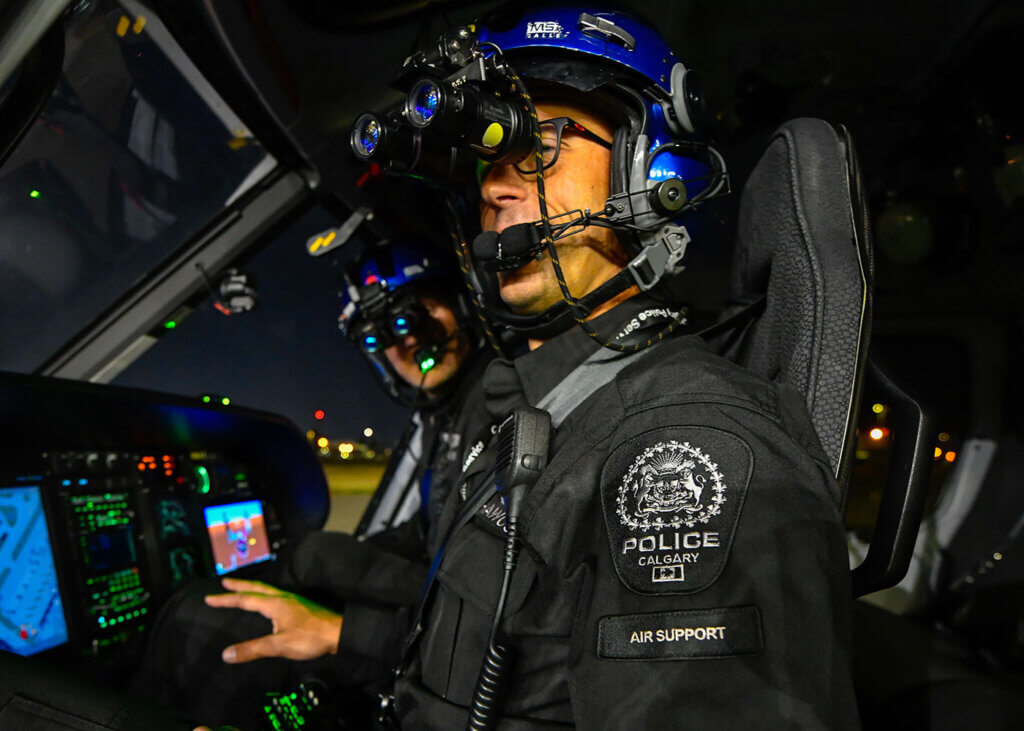
The H125s also include the Churchill Navigation ARS system — now known as the Shotover ARS system — which uses real-time augmented reality mapping and mission management software, allowing officers to overlay street names, for example, or any other data of interest directly over live video in real-time. For the Calgary Police, it gives them better eyes on the ground when tracking offenders.
“If I fly over a school, for example, I turn on the overlay and I can tell you where the gymnasium or the cafeteria is,” Field said. “If we ever have an active shooter, I can tell ground members, ‘OK, he’s in the cafeteria, so you need to head to the southwest corner of the school.’”
HAWCS also implemented the 3SI GPS tracker into the augmented reality mapping system. Once activated, the tracker — often used at banks or stores as a system to trace thieves — will appear on the TFO’s iPad. The TFO can then slew the helicopter’s camera to the tracker’s location.
“It uses cell phone towers, which is sometimes hit or miss, but it gives you a couple meter radius of where that tracker could be,” Vale said. “As it continues to move, by process of elimination, you can actually dial it into a [vehicle], and we can continue to track it.”
The new aircraft also have Luminator HSL1600 searchlights brought over from the EC120s, an upgraded downlink system, and a new audio panel that allows TFOs to multicast or broadcast on numerous channels at one time.

“We’re very happy with the way the [completion] turned out,” Conlin, said. “We’ve got a little over 5,000 operational hours now and [are] very happy with the mission suite we put in.”
With no “off-season” in law enforcement, AMEs conduct heavy maintenance on its aircraft throughout the year — a demanding task for Conlin who is one of just two AMEs at HAWCS.
“It’s a very challenging tempo for us to keep the aircraft always serviceable,” Conlin said. “We have to look for efficiencies and keep a lot of spares and rotables on hand.”
To mitigate this challenge, the air support unit flies one aircraft for 600 hours, conducting smaller 100- to 150-hour type inspections while it’s in service. During that time, AMEs carry out a heavy 600- or 1,200-hour maintenance on the backup helicopter.
“When the primary helicopter is done its 600-hour tour, it comes offline and the freshly serviced one goes online,” Conlin said. “So, we have two helicopters, but we only ever have one in service at a time.”
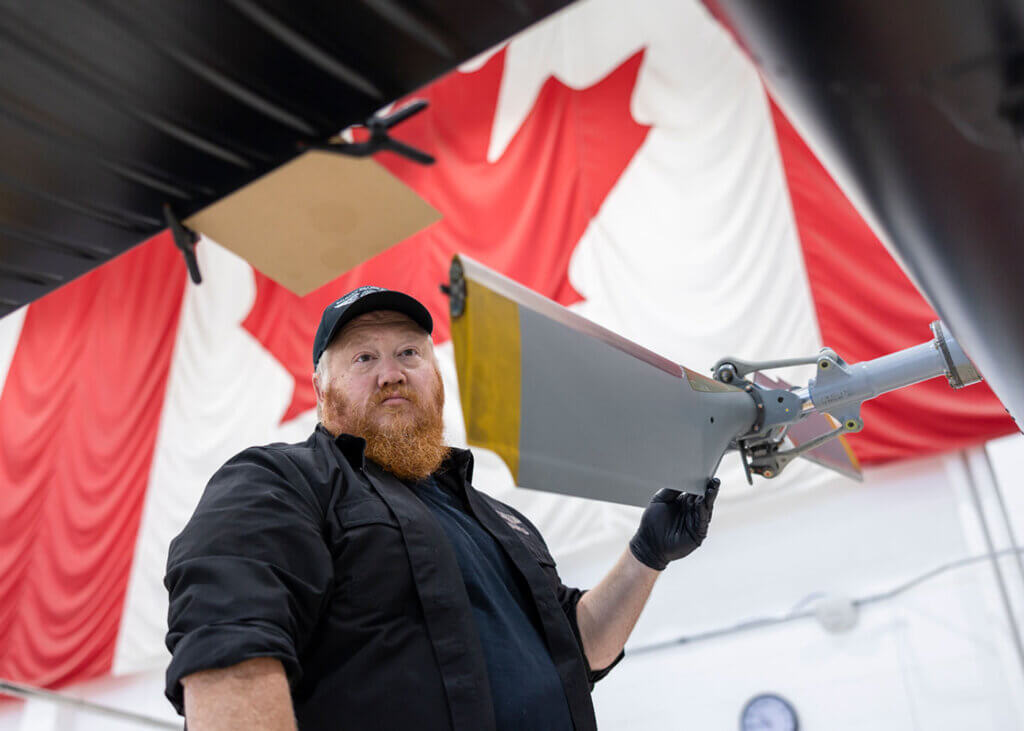
When Vertical Valor visited the facility in 2021, the unit was conducting its 3,000-hour inspection — the first set of overhauls for all of its servos and main and tail rotor gearboxes. Conlin said it was the unit’s “first real heavy inspection [on the H125] where we’ve sent components away for overhaul.”
The maintenance schedule for the H125s has been more frequent than the unit’s former aircraft, with the EC120s spread out in 500-hour increments, but Conlin said “it’s been a fun challenge and a learning curve.”
Otherwise, the maintenance for the H125 is similar to the EC120 in terms of part number systems and tools, but “this is strangely the first tail rotor aircraft I’ve worked on in 20 years, coming from the NOTAR [anti-torque system in the MD 520N] and then the Fenestron [in the EC120], so that’s been fun for me to get to know a tail rotor system for the first time since I was in school,” Conlin said.
Reiterating the value of the HAWCS unit and its H125s acting as eyes in the sky for the Calgary Police, Paziuk said the unit has received significant support from the community it serves. “The helicopter saves lives — there’s no question,” she said. “To the loved one, when we locate their family, whether they’re missing or suicidal, and we prevent them from succumbing to their injuries, time matters, seconds matter. The helicopter can offer that quick response to locate somebody. We’ve proven that time and time again.”





